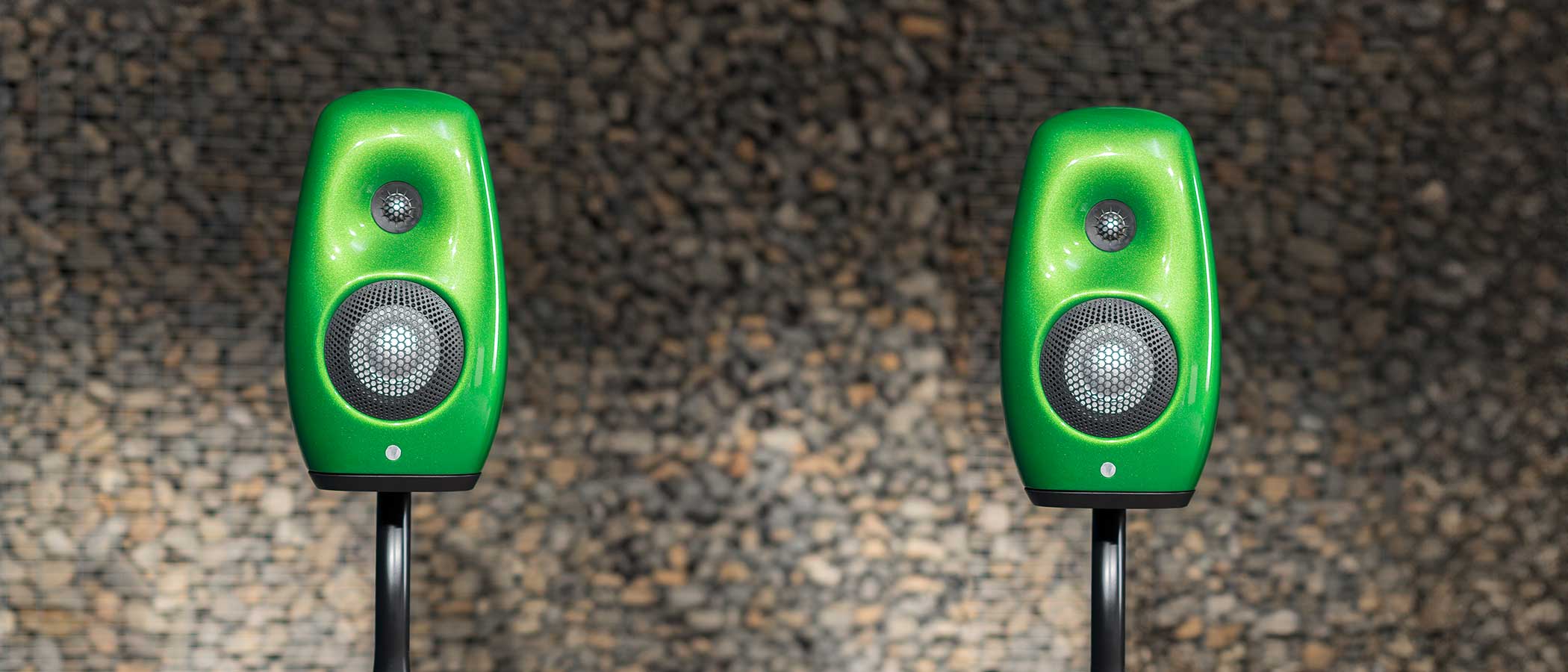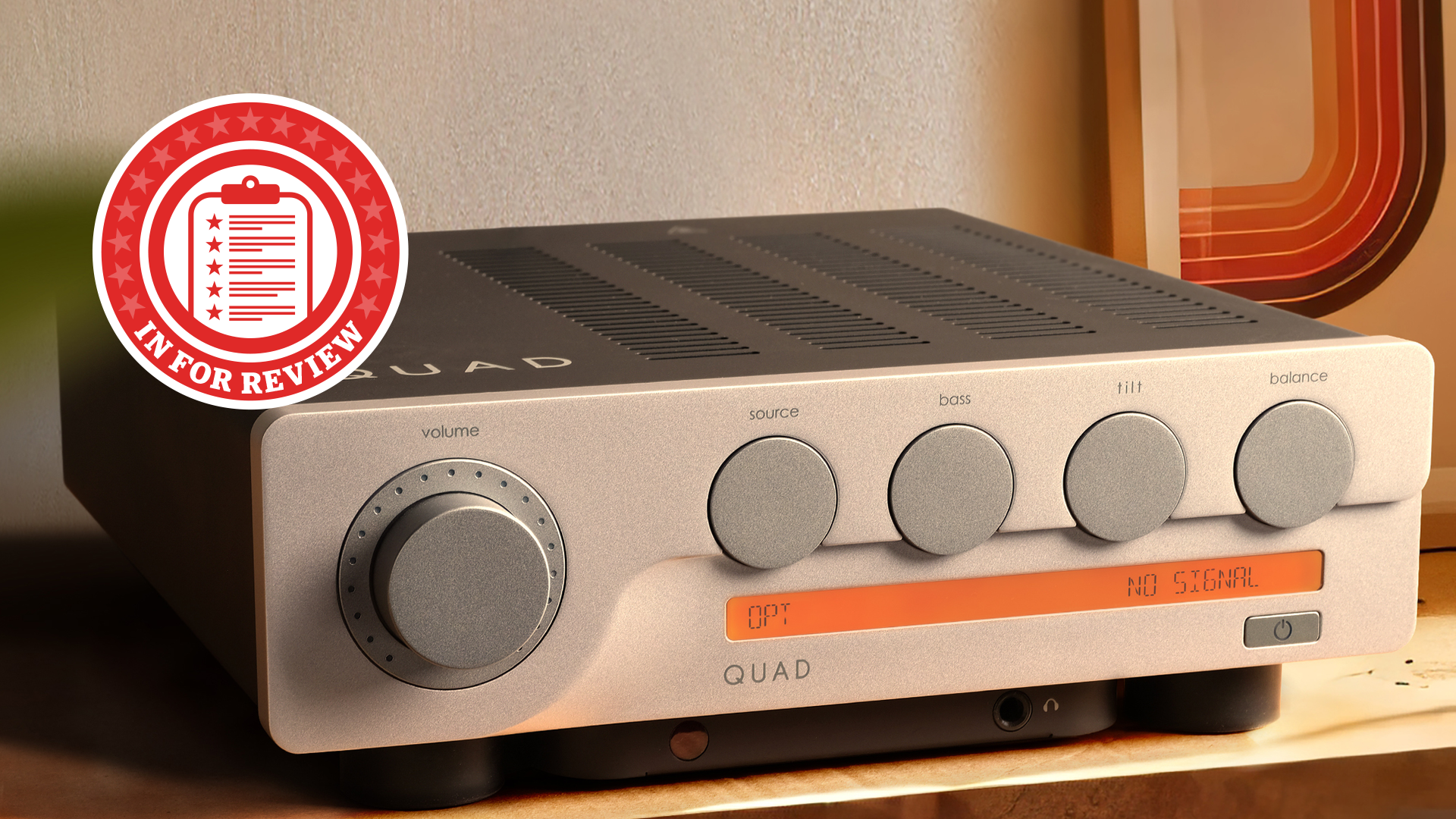Sound+Image Verdict
Turn them up. That’s where the S12 come to life – it’s how they surprise and it’s when their detail and soundstaging merge with power and solidity of bass
Pros
- +
Stunning clarity & detail
- +
Happy loud – and best loud!
- +
Unique design for speakers and (optional) stands
Cons
- -
No biwiring option
Why you can trust What Hi-Fi?

This review originally appeared in Sound+Image magazine, Australian sister publication to What Hi-Fi?. Click here for more information on Sound+Image, including digital editions and details on how you can subscribe.
Vivid Audio’s speakers are famously curvy. Its Giya range is described by the South African company as “a direct, deliberate challenge to every aesthetic and acoustic convention” – although some of the acoustic principles behind them are rooted in ideas that its chief designer Laurence Dickie had previously developed when creating Bowers & Wilkins’ famous Nautilus ‘snail’ speaker, a no-holds-barred project that had been handed to Dickie after the passing of John Bowers himself.
Key to that design was the idea of tapered tube loading (TTL) to absorb the back energy from drivers, energy which would otherwise cause reflections within the cabinet and interfere with the forward radiation, colouring the sound. These tapered tubes contain wool fibre as a damping material, and this is increasingly compressed as the tube tapers, absorbing all sound by the end, so that nothing is reflected back through the diaphragm. Absorbing rather than merely containing the back energy is seen as key to the clarity of the performance of Vivid’s loudspeakers.
You can see this idea in action on any Bowers & Wilkins’ speakers with the famous tweeter-on-top, and a ‘Nautilus’ tube behind it.
But at Vivid Audio, Laurence Dickie applied his “exponential absorbers” as a standard solution for all the drivers, and the extraordinary shapes of the Giya range are the direct result. There was nothing aesthetic about it: Dickie’s designs were pure form following function. Yet as with that earlier Nautilus, their beauty is undeniable, as if we naturally recognise the appeal of a perfect engineering design.
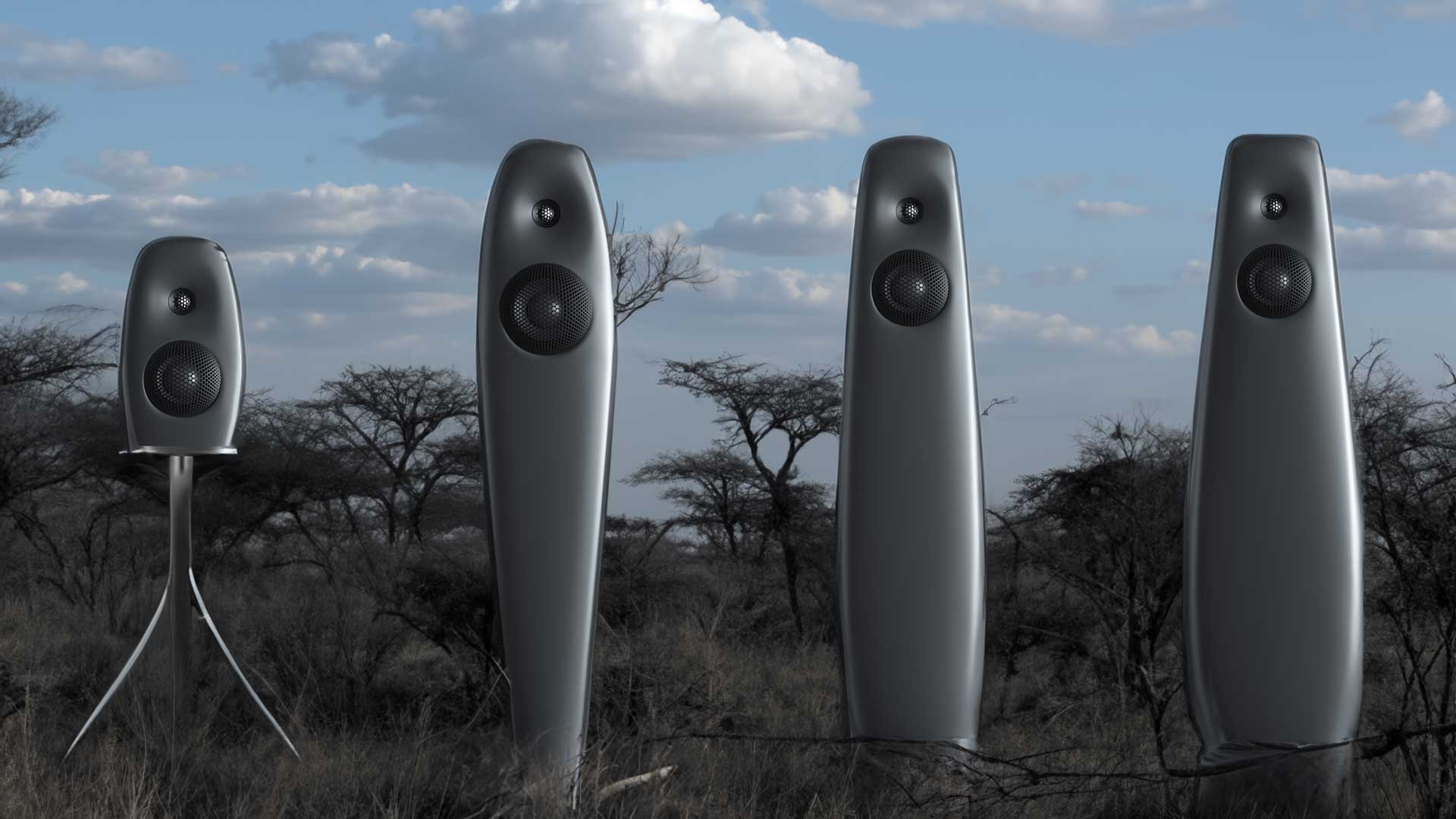
Kaya comes home
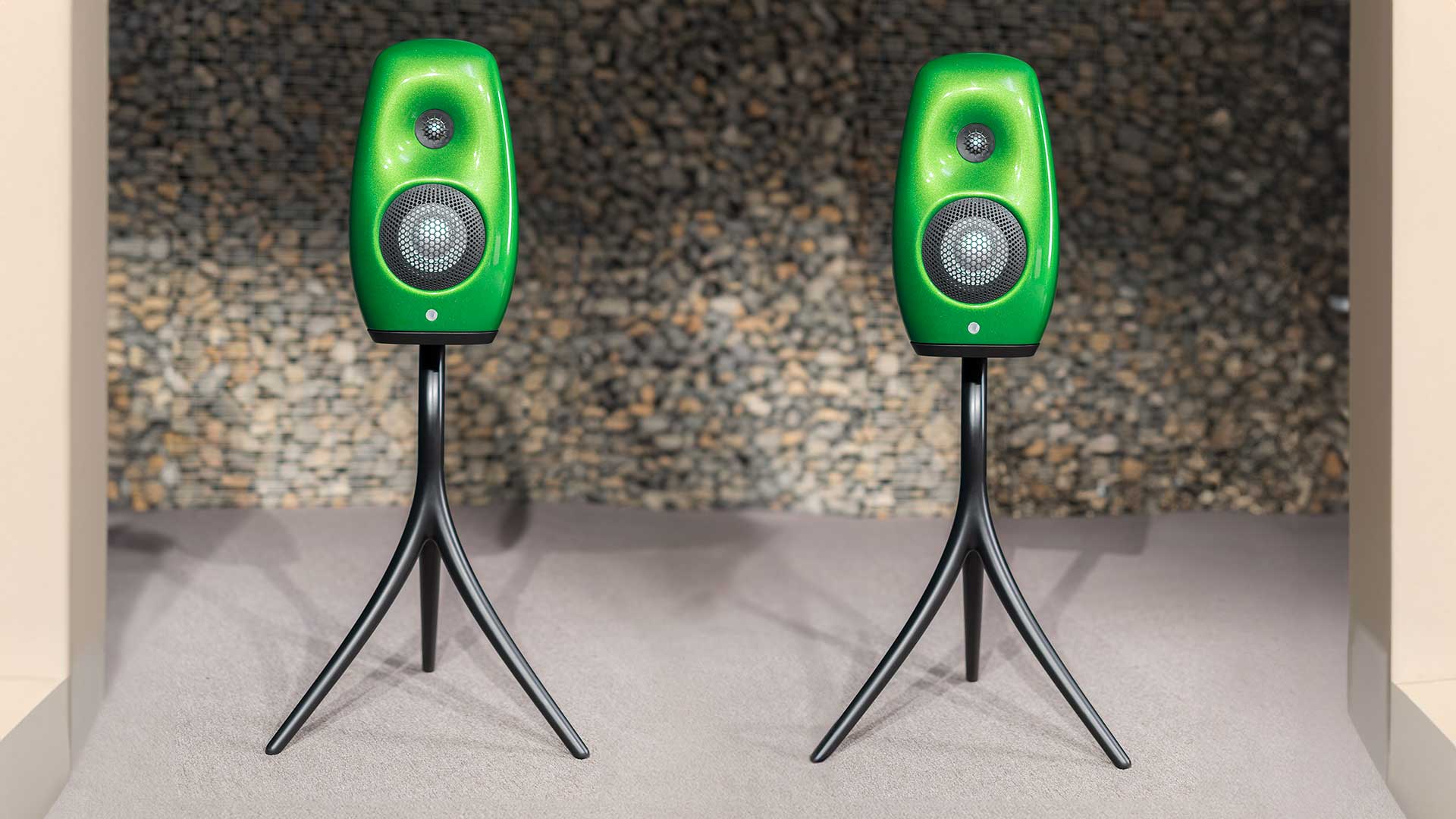
Drivers: D26 26mm alloy-dome tweeter, C100L 100mm alloy-cone mid-bass
Sensitivity: 85dB @ 2.83VRMS, 1m
Nominal impedance: 8 ohms (5.3-ohm minimum)
Quoted frequency range: 45Hz–25kHz -6dB
Dimensions (whd): 400 x 237 x 254mm (but curvy)
Beautiful the flagship Giya collection may be, but they’re not for every home. That led to the ‘Kaya’ range. Kaya is the Zulu word for ‘home’, says Vivid Audio, and is used appropriately since Vivid Audio was originally founded in South Africa, and its production facilities are in the garden province of KwaZulu-Natal, while its design, technical and administration are a little further north… in West Sussex, England.
The whole Kaya ‘home’ concept was intended to extend Vivid’s skills to sleeker and more compact enclosures (in relative terms), creating speakers that integrate more easily into smaller spaces – “perfect for rooms where the sound system is part of the space, rather than the main feature”, as Vivid puts it. The company enlisted the aid of Matt Longbottom and Christoph Hermann for their industrial design, both of whom worked at Lovegrove Studios for industrial designer Ross Lovegrove, the man responsible for the exterior design of the KEF Muon, among other things.
We do like the naming convention for the Kaya range, another tilt to the engineering, since the numbers speak directly to each model’s internal volume: from the 90 litres of the large floorstanding Kaya 90, through the Kaya 45 to the slender and attractive Kaya 25, down to the mere 12 litres of the latest model, these Kaya standmounters. This simple system of nomenclature is thus user-friendly, given that the curvaceous shapes preclude any other easy calculation of cabinet volume (immersion in water might be the easiest way, but no doubt problematic in the longer term).
The latest hi-fi, home cinema and tech news, reviews, buying advice and deals, direct to your inbox.
While the other Kayas are called simply Kaya 90, Kaya 45, etc., these standmounters gain an ‘S’ to make that clear, so ‘Kaya S12’. And there are dedicated stands, to which you might say ‘meh’ until you see them, as they extend the curve concept and make the S12 look still more space-age and other-worldly. The stands also provide security and stability for what are remarkably light loudspeakers that might be less secured merely sitting on random stands, especially if out into the room. The enclosures are formed from what Vivid calls RIMCast PM resin, a kind of initially liquid polyurethane that pours like water into a mould, reproducing the finest details.
And again this isn’t done simply as a way of generating attractive shapes: the construction method also makes the enclosures very stiff when compared to wood.
The construction method also means that the outer layer can be tinted in almost any colour you want, which is very handy if you want the speakers to match the décor of your room. We first saw the S12 in a marvellous tree-frog green at the Australian Hi-Fi Show in April; however, that is a ‘bespoke’ colour option that increases the price. The pair we later reviewed were in white pearl finish, one of the AU$11,000 standard options, with Piano Black and Oyster Matte.
The Kaya range follows all Vivid Audio speakers in using the company’s D26 anodised aluminium alloy tweeter, which tackles break-up resonances in a couple of unusual ways. Firstly, there’s its shape, described as a Catenary Dome Profile (CDP). In geometry, a catenary is the curve formed when a long cable is supported at its ends and then hangs under its own weight – a hyperbolic cosine curve, this is, which differs from a parabola in having a less defined peak. Simple suspension bridges (those without chains or cables) hang in this natural catenary curve, and when inverted it is an efficient form of arch which minimises materials and will always support its own weight. Gaudi was a particular fan of catenary arches, and in more modern times the famous golden arches of McDonald’s are also more catenary than they are parabolic in their curvature.
Use a catenary curve to describe a 3D domed surface and it turns out to have a first break-up mode almost an octave higher than a conventional spherical tweeter dome (to above 44kHz, we gather). This handily minimises resonances in the audible band and promises to keep the midrange particularly clear of irregularities.
In addition to their shaping, Vivid’s tweeters use Laurence Dickie’s innovation from some decades ago of adding stiffness by surrounding the dome’s edge with a ring of highly stiff carbon fibre; this pushes break-up frequencies still higher.

The dome is mounted atop an edge-wound aluminium voice coil that is driven by eight radially polarised neodymium iron boron magnets. According to Vivid Audio, the magnetic flux density in the voice-coil gap that results is so powerful (2.4 tesla) that it could not use ordinary ferrofluid, and Ferrotec Corp (USA) was commissioned to formulate a special recipe specifically for the D26.
And behind the tweeter, hidden in the cabinet, is that fibre-damped, exponentially tapered tube which, according to Laurence Dickie: “has an acoustic performance identical to that of an ideal enclosure, being completely free of resonance or reflection.”
The tweeter crosses over at 300Hz to the mid-bass unit, designated a ‘C100L’, a 100mm alloy cone unit with a notably bulbous dust cap, again an unusual shape which apparently pushes the cone break-up frequency out-of-band by increasing the frequency range over which the cone (and dustcap) move pistonically. Vivid Audio claims most manufacturers either use a dustcap simply to keep dust away from the voice coil or as a way of boosting high-frequency output after the main cone has entered into its break-up zone.
And despite the relatively small cabinet of the S12, the mid-woofer still enjoys a form of exponentially tapered tube loading. Indeed it was discovered that this would have to address not only the usual top-to-bottom cabinet resonances but also, in this smaller two-way model, horizontal resonances. Dickie experimented with a 3D dodecahedron of tubes, then a version folded up into a ball, but he ended up instead using the inside of the enclosure itself, with an inner casing (in maroon above) sitting inside the internal moulding (green), with a series of lateral ribs then forming the channels of the absorber, an arrangement Vivid has called an Omni Axis absorber.
The crossover board sits down the bottom, and offers a single pair of gold-plated banana-friendly sockets just below the small rear port, making bare-wire connections is a little fiddly, though not as much as with larger Kaya models, partly because the S12 are more easily moved around, being quite light (just 6kg each). The minimal weight is something which would also make us less worried about trying their other mounting option, a neat (and of course curvy) wall bracket.
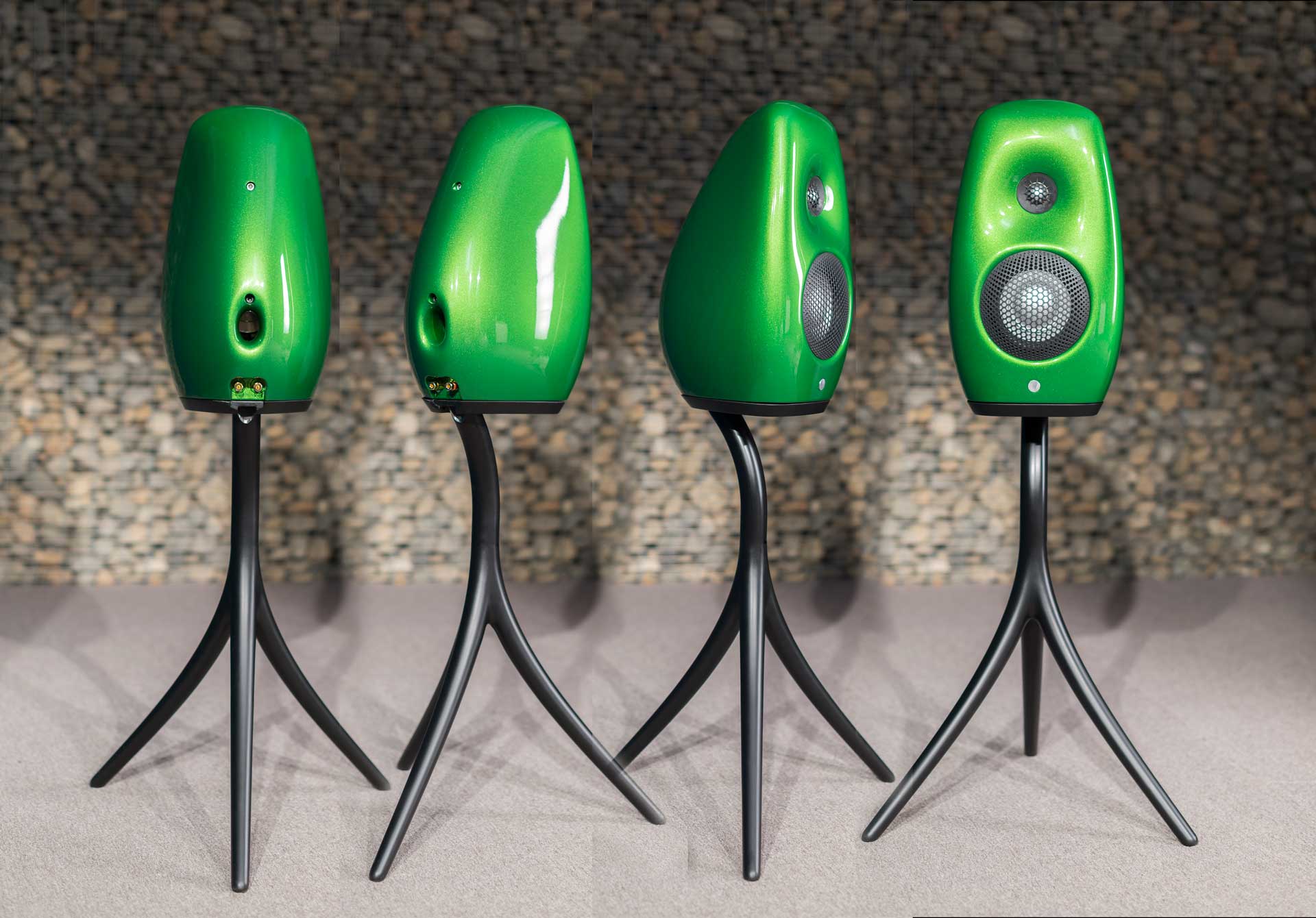
Listening sessions
Any idea that the smallest Kayas might be all midrange and top but no bass was swiftly dispelled by hearing the rich bass underpinning the Dark-side mix of Peter Gabriel’s Four Kinds of Horses, both the tight Tony Levin stabs of almost synth bass, and in the rolling drone which underpinned the whole soundscape, especially deep over the choruses. A sweep showed them picking up full strength above 160Hz, but with a useful audible response right down into the highest 30s of hertz. While they offered nothing for the contrabass D (around 37Hz) of Stereophile’s organ bass tester, they had no problem sounding out the G (at 49Hz).
So no real worries about support from below; it’s perhaps never going to dominate, so that we might have said the S12 are not going to be a dance lover’s dream. But in fact the first time we cranked them into skyward territory was during their warm-up period to entertain a visitor who wanted to hear what these curious bulbous AU$10k standmounts could do. And her choice was French musician and DJ Clo-Zee – whose ‘Neon Jungle’ remixes are full of wide detailed audio cues which the Kayas portrayed magnificently, including the pulse of the synthesised 'bottom F' on the first track, Perfect (Of the Trees Remix): that’s 44Hz, no problem, thank you.
The other bass delight for EDM fans is the speed of response here, the transient edges available particularly for the squarer pulses of electronic bass, and especially during any accelerating build-ups to drops – so tight, so much air-shifting available from the alloy bass cone that you could feel the pulses in the air.
This is perhaps the defining characteristic of the S12 across the frequency range: the sharp-edged clarity given to every element, and the impeccable soundstaging that comes with this clarity of detail. This brought acoustic recordings to absolute life. The recently-released 1994 recording of Keith Jarrett playing sonatas by Bach’s son Carl was spellbinding in its nicely simple stereo miking, and further showed the even range of these speakers from high to low, a true realism of tone.
As is often the way with highly revealing speakers, they can sometimes be a little too revealing of less-than-perfect recordings. We couldn’t on this occasion play Alex The Astronaut’s early and wonderful Already Home too loud, because the Kayas were pretty brutal on the boxy treated vocal; fine at moderate volume, but it just got boxier with more level.
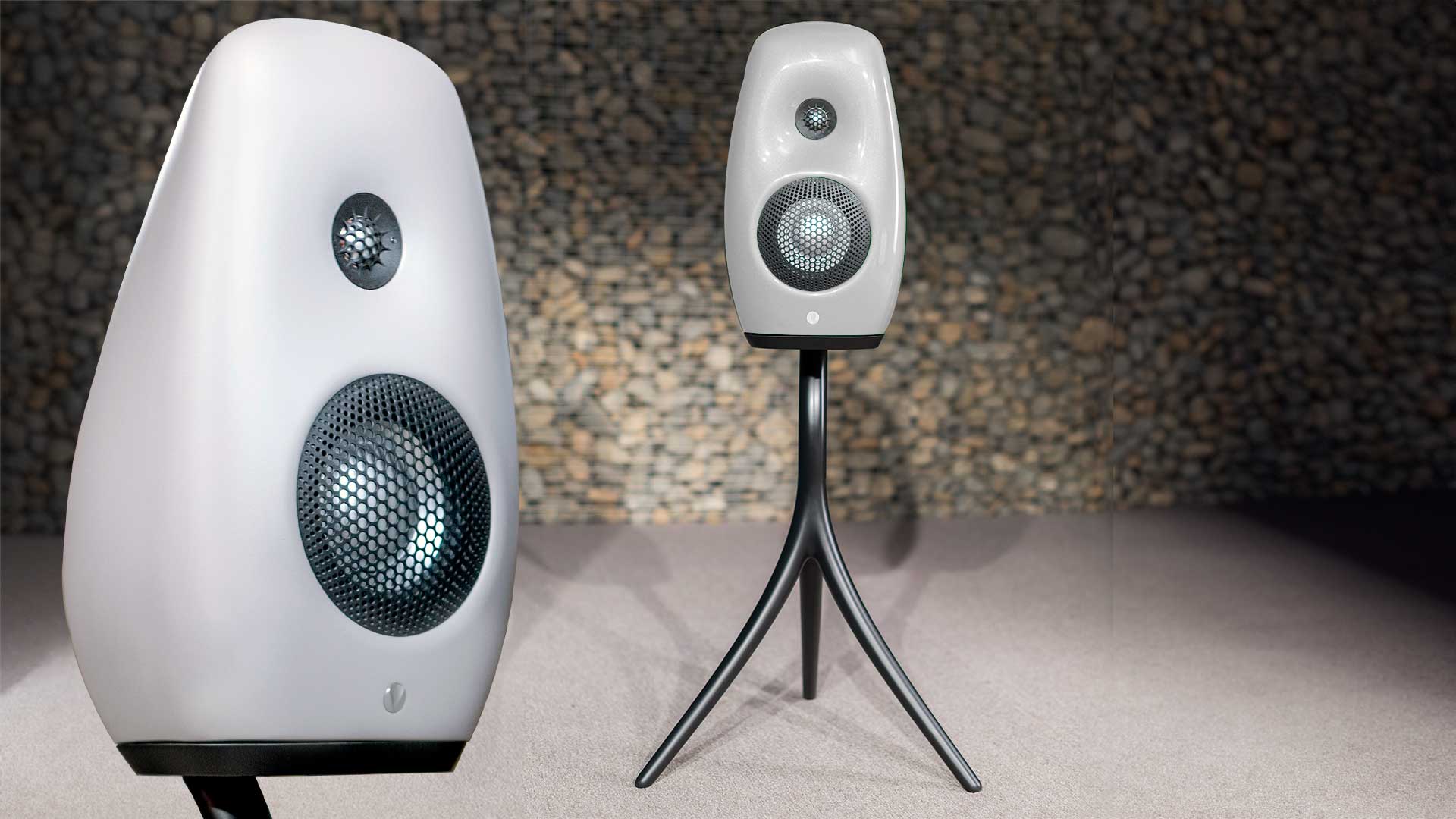
This was unusual because, on the whole, the S12 just loved going loud; they begged for it. The better the production, the better they sound. ‘The Dark Side of The Moon’ (50th anniversary remaster) we turned up and up, so that we were in among the swirling synth lines of Any Colour You Like, enjoying Nick Mason’s drums sounding astounding real, and were jolted by the flanged guitar break clanging in like a metallic bell before the guitar part becomes split across the stereo soundstage for the jam down into Brain Damage.
Look What You’ve Done by Radio Free Alice (the Melbourne band, not the Darlinghurst record shop) sounded fantastic, a big tom boom from the right channel before settling in all jangly Cure in the centre, and all that Vivid tightness allowing the kick drum to smack through the central scrum, over which the vocals emerged sounding engagingly real.
Female vocals were equally well served: Diana Krall was real and perfectly poised out in front of the mix singing 10CC’s I’m Not in Love, while Taylor Swift on Cruel Summer sang out clear on the verses, though recessed enough on the choruses to again encourage us to turn things up higher, to get her voice sounding real, and then the music thumping and immersive. This was something of a characteristic which emerged: at lower levels, vocals could drop back in the presentation, perhaps the level of resolved detail in the rest of the mix had this effect, but the answer was always the same: turn it up to get the vocal sounding real, and the surrounding music would just burst into even greater life.
When we did this with Getaway Car, the S12 again revealed their available bass by rolling out the fundamentals on the powerful choruses – though again, to their best when they were playing nice and loud.
The reason we could keep turning up the Kaya S12 is because they remained so solid and audibly free of distortion. We had them at levels where lesser standmounts would scream and we’d have to drop them lower. Such is the balance here that you simply don’t realise how loud they are running. It’s great! If you audition a pair, we recommend you settle in, then nudge and nudge them up, and take the time to enjoy them loud; it’s what they do best.
- The best stereo speakers: entry-level to premium
Beyond music
We had the S12 for about a month, and for part of that time we had them connected to our TV audio; they looked spectacular flanking the TV even with their rubber feet on a TV bench, while they will surely qualify as artworks in their own right when freestanding on their bespoke curvy supports flanking a wall-mounted screen.
We ran the Bowie doco Moonage Daydream on Netflix, and the S12 made it all so clear – magnificent and musical, wide and involving, diamond-sharp and again tight, tight, tight. This snap was doubly evident on the beats and rolling rises that chart the soundtrack of Hiphop Evolution, where Grandmaster Flash, Eddie Chiba, Kurtis Blow, even soundtrack taken from old videos sounded crisp and kicking. Tonal accuracy and an ability to play loud without distortion benefits TV and movies just as much as music, so don’t hesitate to use the Kaya S12 in such a dual role.
Indeed there’s a Kaya 35 centre speaker, so with a suitable subwoofer you could have a whole Kaya home cinema set-up of gleaming bulbous speakers around the room; the clarity and kudos would be mega!
What didn’t we like? Nothing! Only that if you listen to them at an ordinary volume, you won’t be hearing them at their best. It’s what they can do with a good amp at high levels which makes the Kaya S12 standmounts stand out musically, while their appearance certainly makes them stand out visually. Especially in tree-frog green.
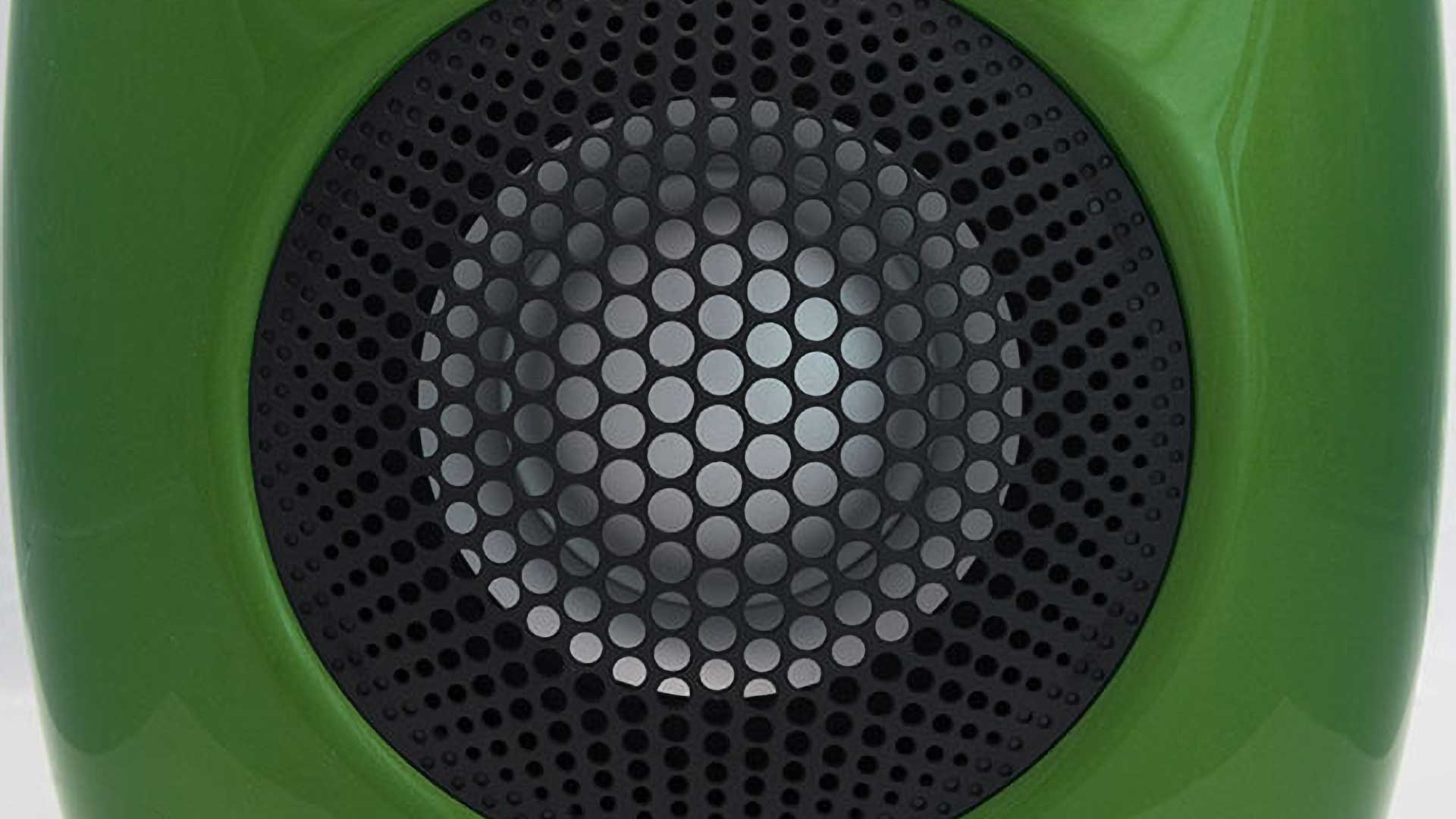
Verdict
Up for an audition of the Kaya S12? For God’s sake, turn them up! That’s the level at which Vivid’s design ideals are confirmed; it’s where the S12 come to life, it’s how they surprise, and it’s when their wonderful detail and soundstaging merge with a surprising sense of power and solidity of bass. Remember that their beauty is not skin deep; it lies within.
- Check out all the Australian reviews from Sound+Image & Australian Hi-Fi magazines

Jez is the Editor of Sound+Image magazine, having inhabited that role since 2006, more or less a lustrum after departing his UK homeland to adopt an additional nationality under the more favourable climes and skies of Australia. Prior to his desertion he was Editor of the UK's Stuff magazine, and before that Editor of What Hi-Fi? magazine, and before that of the erstwhile Audiophile magazine and of Electronics Today International. He makes music as well as enjoying it, is alarmingly wedded to the notion that Led Zeppelin remains the highest point of rock'n'roll yet attained, though remains willing to assess modern pretenders. He lives in a modest shack on Sydney's Northern Beaches with his Canadian wife Deanna, a rescue greyhound called Jewels, and an assortment of changing wildlife under care. If you're seeking his articles by clicking this profile, you'll see far more of them by switching to the Australian version of WHF.
